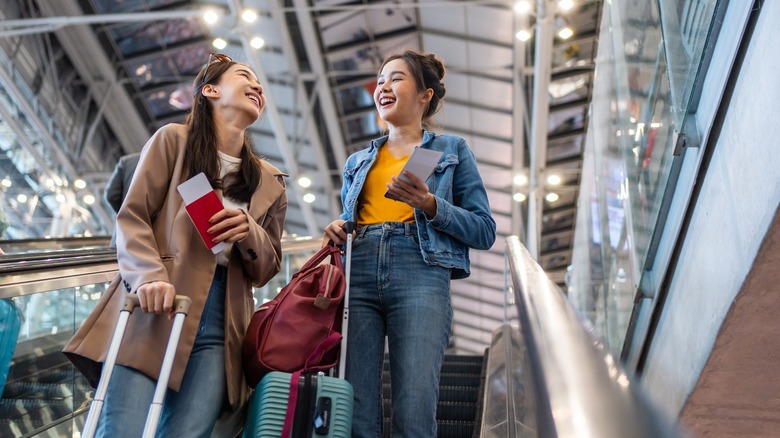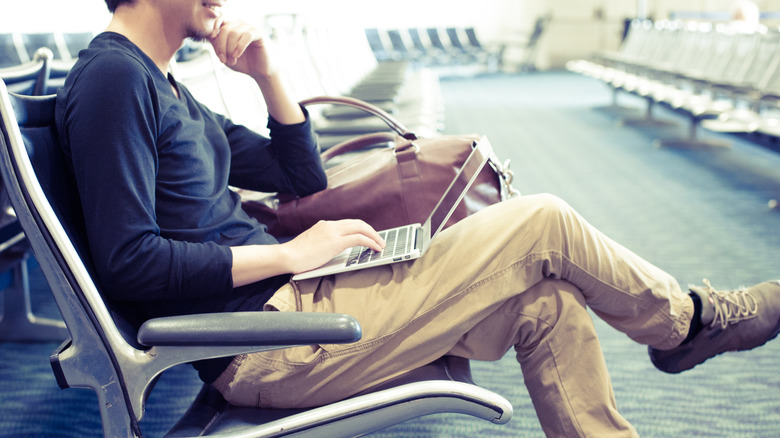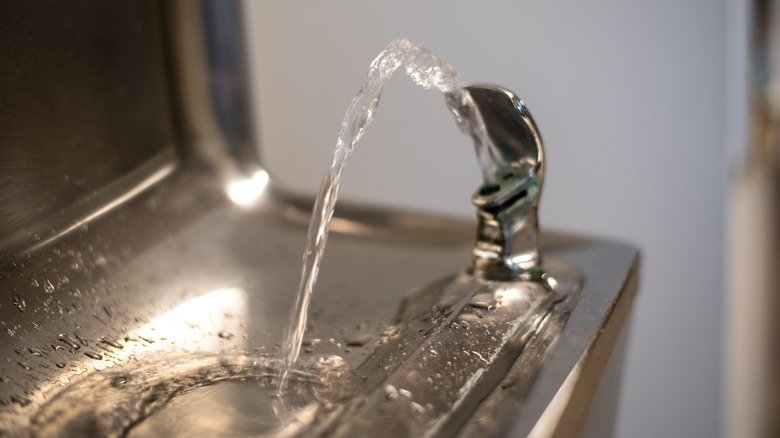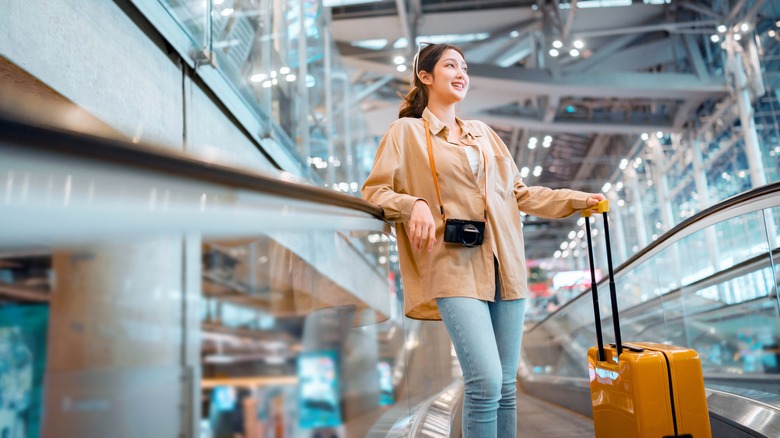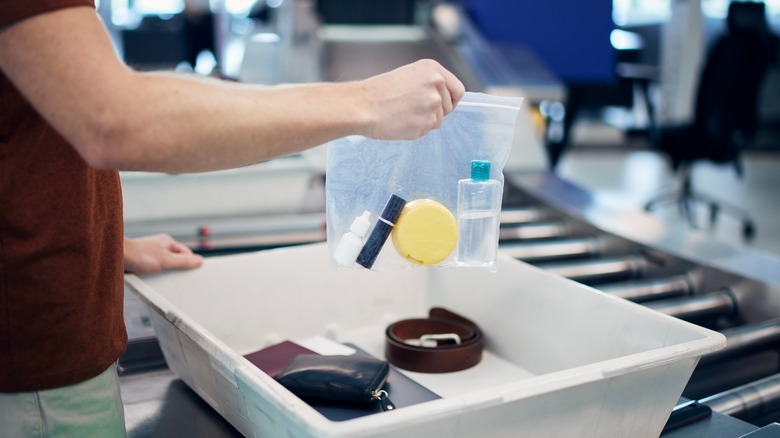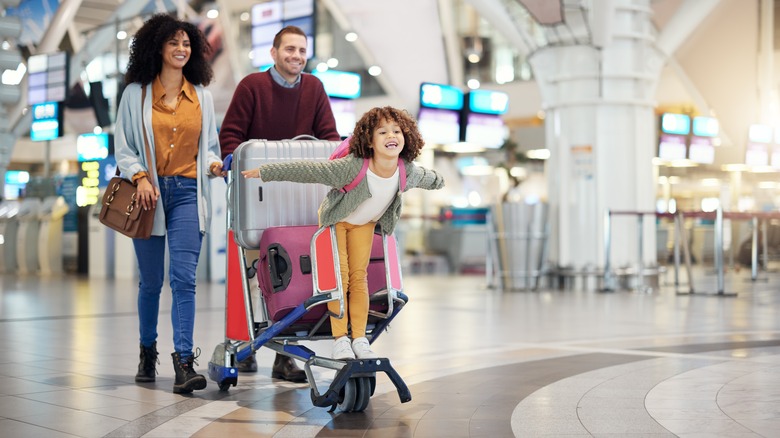These Are Easily The Filthiest Spots In An Airport
Airports are fun, right? Typically — unless you really love airport food and don't mind the drive — heading to one means that you're about to hit the skies and travel somewhere exciting. Whether you're visiting some of the oldest cities in the world, dining your way through Michelin-starred restaurants, or simply kicking back and sunbathing in a tropical destination, airports are synonymous with new adventures, unexplored culture, and countless possibilities. But — and here's the less glamorous part — they're also teeming with germs and grime.
Put simply, airports are hubs for disease and bacteria. After all, when more than 2.9 million passengers pass through U.S. airports a day, it makes sense that their germs would come along for the ride too. And what better place to settle in and make a home for themselves than high-traffic surfaces and areas that are in contact with people on a continuous basis?
Far away from the bathrooms — which are actually a lot cleaner than you think thanks to new tech and passenger feedback — the dirtiest place in the airport is your first stop: self check-in kiosks and their accompanying touchscreens. However, the battle doesn't stop there. From armrests to handrails and TSA bins to water fountains, it's basically a game of minesweeper — with the ultimate prize being not getting sick.
Armrests
Coming in second as one of the dirtiest spots in the airport are the coveted gate bench armrests. When it comes to travel jackpots, there are few things out there that will make you feel better than snagging a seat right by the counter — especially if you're a nervous flier who's constantly worried about missing your flight. However, it's exactly this reason that makes armrests so gross.
Not only do these come in contact with thousands of passengers a day, but they also accumulate a variety of germs and bacteria from constant handling and, in some cases, lack of proper disinfection. In fact, according to a 2017 study by Texas-based company InsuranceQuotes, researchers found a whopping 21,630 colony-forming units (CFU) — which are basically clusters of viable bacteria — per square inch. That's basically equivalent to the number of germs found in a kitchen sink (21,000 CFU). Can passenger YUCK! report to gate H9, please?
Water fountains
Feeling thirsty and want to avoid unnecessary germs? You might be better off paying for an over-priced bottle of water instead of hunting down a public drinking fountain. According to the same study by InsuranceQuotes, airport water fountains — specifically, the water fountain buttons — sit comfortably as the third dirtiest spot. With a reported 19,181 CFU per square inch, you'd probably find the same numbers by testing a used pet toy (roughly 19,000 CFU). Much like the armrests, the reason for these high numbers of germs is that these surfaces aren't frequently cleaned — at least not well — which makes them a hotbed for bacterial activity.
Luckily, though, airports around the country have started to implement filling stations that might change this for good. Especially since some of these don't even require you to touch them. Just place your reusable water bottle where marked and the machine will fill it — no spills — to the top. Saving $5, staying germ-free, and helping the environment? Yes, please.
Stair and escalator handrails
Another germ-infested spot to look out for? Escalator and stair handrails. Much like the armrests and water fountain buttons, handrails come in contact with thousands upon thousands of travelers every day — and there's no way to tell when the last time these passengers properly washed or disinfected their hands.
Once again, this high level of exposure means that handrails can accumulate a wide range of microbes, especially when the frequency of cleaning can't keep up with the constant influx of new germs.
Not to scare you off from holding on to a handrail if you need to, but in a study conducted by Charles Gerba, professor of environmental microbiology at the University of Arizona (via Business Insider), traces of blood, urine, saliva, and — wait for it — even feces were found on handrails in highly-frequented areas. If that doesn't make you want to disinfect your hands after every step down the stairs, it will at least make you more cautious and mindful of hygiene.
TSA bins
TSA is already nerve-wracking enough — now add the possibility of getting sick on top of that and it's a recipe for anxious-traveler disaster. Another high-traffic area, airport security checkpoints require passengers to touch pretty much everything they have with them: from the spare change in their pocket to their phones, roller suitcases, and even shoes. This means they're not just touching their belongings, but also everything else that their possessions have been in contact with. That roller bag? It's been dragged through the parking lot, the airport, and maybe even into the bathroom. Those shoes? They've walked through all that and more. And unless they've been thoroughly cleaned and sanitized before getting plopped on the belt, you're touching all that muck too when you use the bin another traveler left behind.
In fact, a 2018 study published in BMC Infectious Diseases even revealed that 50% of TSA security trays often have traces of respiratory viruses on them. Among these were the rhinovirus (aka the culprit for the common cold), coronavirus, adenovirus, and influenza A.
Staying safe at the airport
Now, you might be wondering, "How can I make sure I don't get sick when literally everything at the airport is out to get me?" The answer is pretty simple: Wash your hands. Frequent and thorough handwashing is your best defense against these germs. According to the Centers for Disease Control and Prevention (CDC), you'll want to use soap and water and scrub for at least 20 seconds before rinsing. Doing so after coming in contact with potentially infected surfaces can get rid of roughly 90% of harmful germs, per Harvard Health.
If soap and water aren't available, the CDC also recommends using a hand sanitizer with at least 60% alcohol as another great way to keep yourself safer from germs. Make sure you use enough to cover all areas of your hands and rub them together until they feel dry. While hand sanitizer might not get rid of all the germs, it's still a lot better than going about your day with dirty hands.
Lastly, carrying a travel-sized pouch of disinfectant wipes to clean high-touch areas — like armrests, tables, and even buttons — can provide some much-needed peace of mind if you're unsure when you'll get to clean your hands. Prevention is a lot better than cure — especially if you're not into the idea of spending your holiday weighed down by illness.
